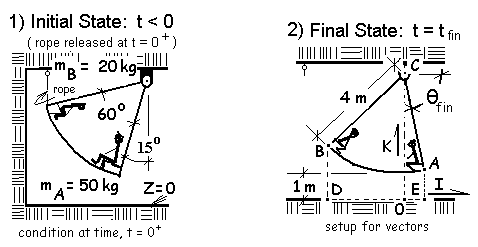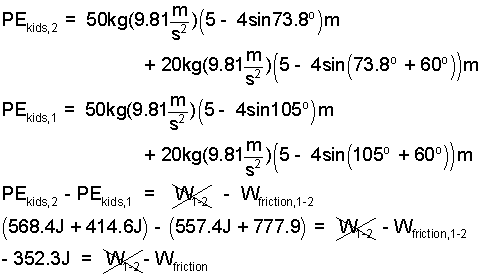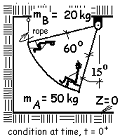| THERMO Spoken Here! ~ J. Pohl © | TOC NEXT ~ 153 |
Kids on a Swing
Two children sit in a porch swing which is initially restrained from motion by a rope, 1). When child B releases the rope, the two swing through air until the swing and boys cease to move. The final, at rest angle (θfin), defines the final condition of the system, 2).
 |
Calculate the final angle the boys and swing will attain.
♦ Our obvious system is the two masses (let it be two boys) with their positions constrained by the swing. (Even if we knew the mass of the swing we would ignore it for this first calculation). The event is "incremental" in time. We write the Extrinsic Energy Equation omitting friction work - it is small. Furthermore, no one is pushing the swing, meaning ΣW = 0.

| (1)1 |
The initial and final velocities of the boys are zero. Potential energy change is expected.

| (2) 2 |
Whoops? Something is wrong. Our equation says the boys will have no changes of potential energy? That is absurd. Our error is that we cannot drop friction, however small, for with no friction the boys would swing forever. Returning to the Extrinsic Energy Equation with ΣW included, we reduce it again as follows:

| (3) 3 |
Since friction is difficult to quantify, we usually ignore it. In the above equation, potential energy, as a function of swing angle, is the way we must proceed. The potential energy of the boys can be written for the boys collectively in terms of their common center of mass i), or as a sum of their individual potential energies, ii):

| (4) 4 |
We will use the second option. The initial angle is 15°, and the final angle is θfin.

| (5) 5 |
What next? Well, the geometry of the swing will tell us all of the values of z for any θ. But even with that, the above equation has two unknowns which are the final angle θfinand the friction work W1-2,friction. What can we do?
Well the swing has flexible ropes and as sure as water flows downhill, the boys will swing until they arrive at a final angle that corresponds to the second, least possible potential energy they might have (constrained as they are). In the above energy equation, the potential energy of boys is written as a function of angle, θ. We will use the geometry to write the elevations, (z's) in terms of θ, then differentiate that expression, set the result equal to zero and solve for θfin, least PE.
The original sketch shows a datum for potential energy (z = 0) at ground level beneath the swing. The potential energy of the two boys (we assume their masses positioned precisely at points A and B) can be written as a function of the angle θ:

| (6) 6 |
The θ we seek is constrained by the second position; the angle θ. Vectors provide a disciplined approach to write these final positions. The final elevation of boy A, equals the distance between points A and E. We sketch a vector origin and basis on the figure and start our vector path at O.

| (7) 7 |
Our answer can be obtained from the K component:

| (8) 8 |
Now for the elevation of boy B...

| (9) 9 |
And by the K component again.

| (10) 10 |
The system potential energy can now be written:

| (11) 11 |
So the equation for the final position is:

| (12) 12 |
Let us create two simple cases to check the "truth" of this equation.
i) If the mass of boy B is zero, after the swing stops, Boy A will be vertically below the pivot and the swing angle, by our result, had better be 90 degrees.

| (13) 13 |
ii) If the mass of boy A equals zero, the final position of the swing will have an angle with horizontal of 30 degrees.

| (14) 14 |
The formula for the cosine of a sum of angles was derived using vectors in Chapter 1. By use of that we obtain a general result:

| (15) 15 |
Applying the masses of the boys yields: θ = 73.8°
As a final step we can apply this information to the energy equation.

| (16) 16 |
In conclusion, we see the system potential energy change was - 352.3 Joules which equals the friction work of the event.

Kids on a Swing
Two children sit in a porch swing which is initially restrained from motion by a rope, 1). When child B releases the rope, the two swing through air until the swing and boys cease to move. The final, at rest angle (θfin), defines the final condition of the system, 2).
Calculate the final angle the swing will attain.
Premise presently unwritted!